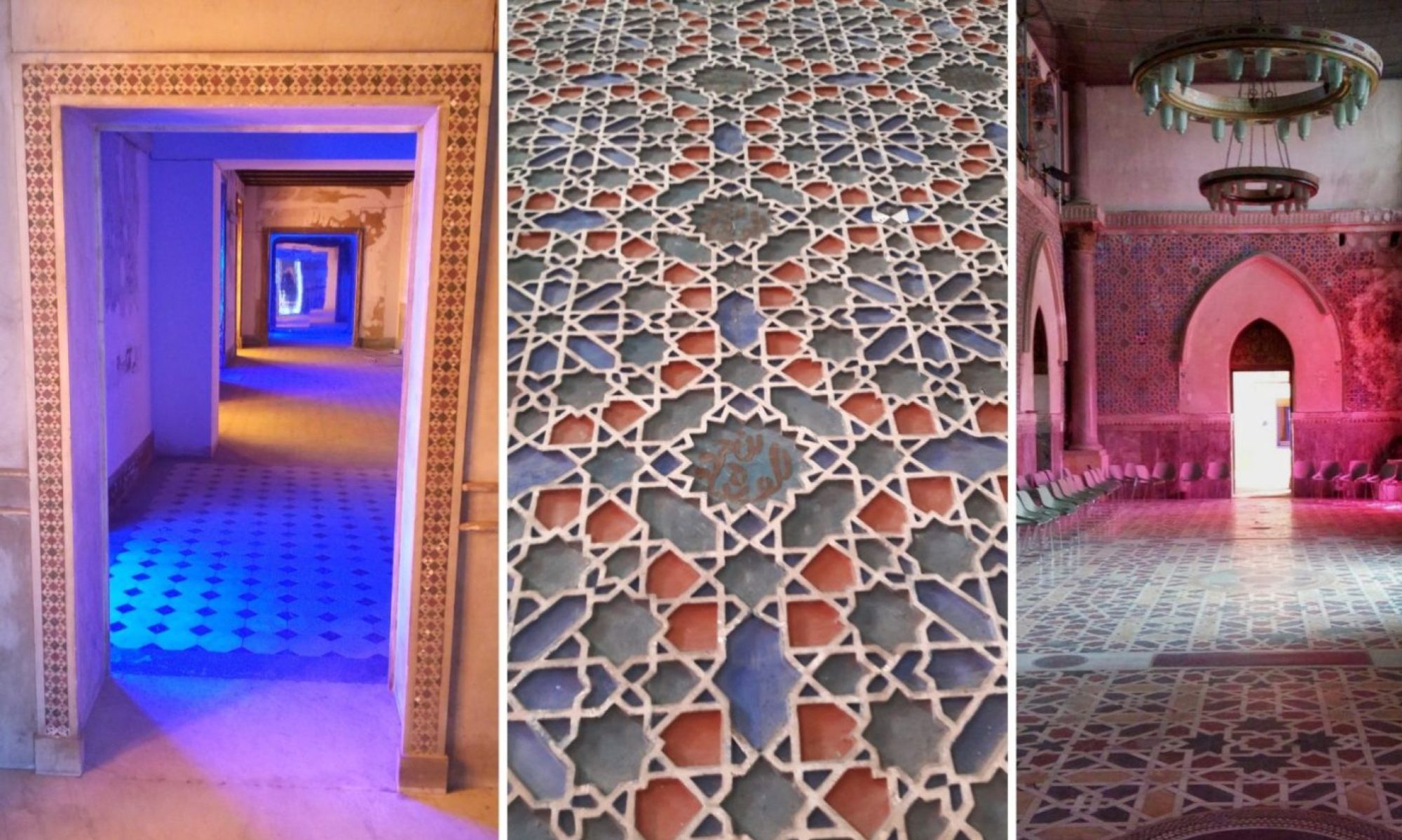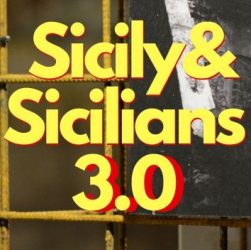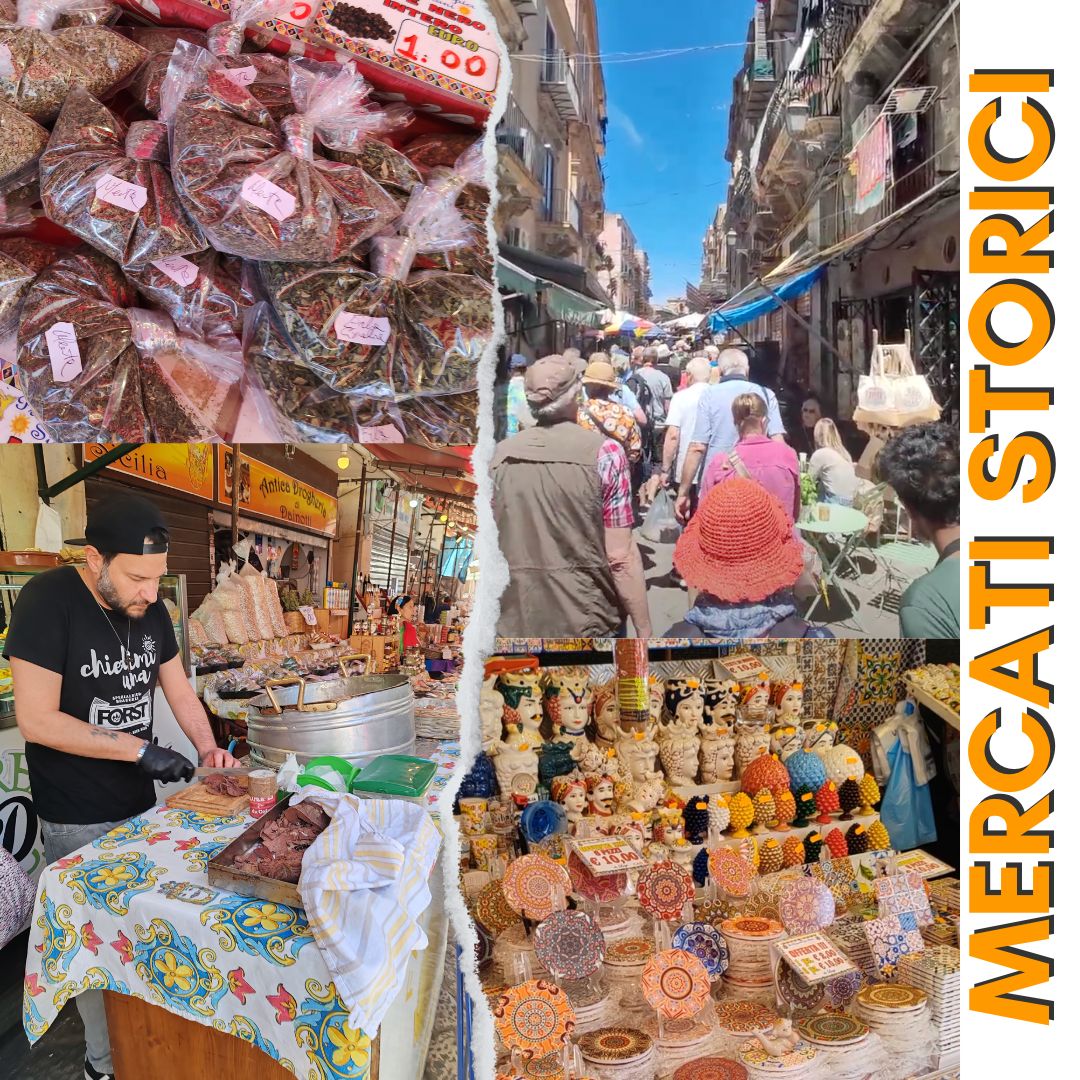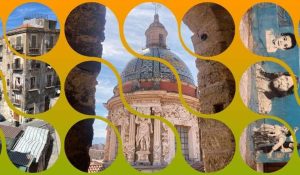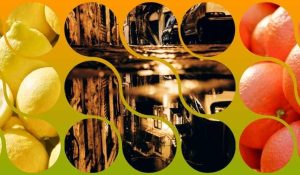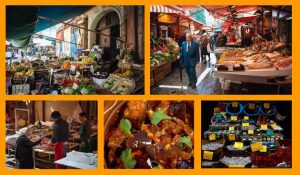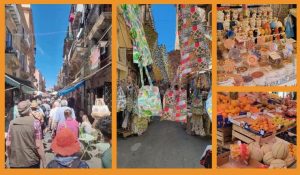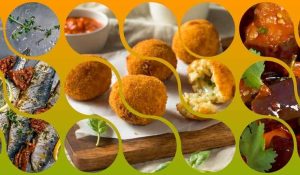[:it]
Dai mercati storici a sontuosi palazzi, il fascino della Sicilia è veramente senza rivali. Ogni regione e città ha le sue storie e la sua cultura uniche. Palermo, la città più grande e il capoluogo dell’isola, offre un incanto particolare grazie all’amalgama di culture tradizionali e alle sue vivaci dinamiche che si sintetizzano nei suoi mercati.
Gli antichi tempi di Palermo e le influenze arabe
La città di Palermo è stata un crocevia di imperi nel corso della sua storia, ognuno dei quali ha lasciato un’impronta unica sulla cultura e sul carattere della città. Greci, romani, bizantini, arabi e normanni hanno portato con sé patrimoni unici che oggi si riflettono nell’architettura, nella cucina e nelle tradizioni della zona o anche solo nel gesticolare o parlare dei palermitani.
Fondata nel 734 a.C. dai Fenici come centro commerciale, fu sotto il dominio romano che la città iniziò a prosperare come parte cruciale dell’approvvigionamento di grano dell’impero; le terre fertili e la posizione strategica della città contribuirono alla sua importanza come strategica risorsa per il grano.
Sotto la dominazione araba nel IX secolo, Palermo conobbe una vera e propria “età dell’oro”. Questa svolta positiva fu caratterizzata dalla prosperità economica, dalle attività intellettuali e dall’innovazione artistica. Gli arabi introdussero sistemi di irrigazione molto avanzati, nuove colture come gli agrumi e uno stile architettonico distintivo e tipico che ancora oggi connota Palermo che fondeva elementi islamici, bizantini e normanni. Questo stile è visibile ancora oggi nei mosaici, nelle cupole e negli archi della città, in particolare in punti di riferimento come la Cappella Palatina e il Castello della Zisa.
Gli arabi portarono in Sicilia e a Palermo importanti innovazioni; significativi furono i loro contributi nel campo della medicina, con la creazione di ospedali e l’introduzione di nuovi trattamenti e rimedi sanitari.
Un’impronta ancora oggi visibile… i mercati di Palermo, come i famosissimi Ballarò e Vucciria, riecheggiano i vivaci souk del Nord Africa, con venditori di spezie, olive e dolci che ricordano i bazar mediorientali.
Ballarò: Il mercato piu antico e vivace
Il mercato di Ballarò a Palermo è un’icona vivente della tradizione e della cultura siciliana; esso rappresenta un angolo pulsante della vita quotidiana palermitana da secoli ed è super attivo ancora oggi. Situato nel cuore del centro storico della città, Ballarò è rinomato non solo per la sua ricca offerta di qualunque prodotto e cibo, ma anche per la sua profonda connessione con la storia e le tradizioni locali.
Le radici del mercato di Ballarò affondano nell’epoca dell’occupazione araba della Sicilia, che come suddetto, risale al IX secolo. Durante questo periodo, Palermo divenne un fiorente centro commerciale e culturale, e il mercato di Ballarò emerse come un punto nevralgico di scambio di merci provenienti da diverse parti del Mediterraneo. Il nome “Ballarò” è comunemente ricondotto alla parola araba “balhar”, che significa “confusione” o “tumulto”, evocando l’immagine di un luogo vivace e caotico, riflesso della sua atmosfera caratteristica e dinamica.
Passeggiando per le strette vie del mercato, vi troverete immersi in un ambiente vibrante, caratterizzato da profumi, suoni, volti, etnie, lingue e accenti… un’esplosione di suoni e colori. Il chiacchiericcio incessante dei venditori che offrono i loro prodotti che raggiunge tonalità apicali nelle classiche “abbanniate” (grida dei commercianti), il rumore delle pentole e delle padelle in movimento e i profumi irresistibili del cibo di strada creano un’esperienza sensoriale unica. I venditori sono molto spesso veri e propri protagonisti del mercato, sono noti per il loro entusiasmo e per l’abilità di coinvolgere i passanti con i loro racconti e le loro offerte.
[Best_Wordpress_Gallery id=”299″ gal_title=”mercato storico palermo ballarò”]
Tra le specialità gastronomiche che troverete, le arancine (deliziose polpette di riso ripiene, impanate e fritte) (attenzione, a Palermo”sono femmine”, lo sfincione (una pizza rustica tipica di Palermo piena di cipolla e acciughe) e le panelle (le tipiche frittelle di ceci, il vero street food della città) sono solo alcune delle prelibatezze che arricchiscono l’offerta culinaria. Inoltre, il mercato offre una vasta gamma di piatti a base di pesce freschissimo, pasta fatta in casa e altre specialità tipiche che celebrano la ricca tradizione culinaria siciliana.
L’eclettica varietà di prodotti disponibili al mercato di Ballarò è sorprendente. Dalla frutta e verdura fresca, spesso coltivata localmente, ai prodotti artigianali unici, a oggetti di antiquariato e modernariato e ai souvenir caratteristici, il mercato è un paradiso per coloro che cercano autenticità e originalità. Ogni bancarella racconta una storia, e la possibilità di contrattare direttamente con i venditori aggiunge un ulteriore strato di coinvolgimento e interazione.
Ma Ballarò è molto più di un semplice mercato: è un palcoscenico per la cultura vivente di Palermo; qui, gli incontri tra etnie, status, locali e turisti sono continui permettendo di scoprire usanze, tradizioni e storie personali che arricchiscono l’esperienza del visitatore. Le conversazioni con i venditori e i residenti offrono uno spaccato autentico della vita quotidiana, lontano dai circuiti turistici tradizionali.
Il mercato di Ballarò è un luogo straordinario per gli appassionati di fotografia… l’atmosfera vibrante, i colori vivaci dei prodotti e delle bancarelle e i murales che adornano le pareti circostanti offrono infinite opportunità per scatti memorabili. Ogni angolo del mercato, con le sue scene vivaci e i suoi dettagli unici, è una tela perfetta per catturare l’essenza di Palermo e la sua vivacità.
In sintesi, il mercato di Ballarò non è solo una destinazione per acquistare beni e cibo; è una celebrazione della cultura e della storia di Palermo, un’esperienza immersiva che offre uno sguardo autentico sulla vita siciliana e un’opportunità imperdibile per tutti i sensi.
La Vucciria
E’ stato uno dei più noti, oggi ha abbandonato la sua identità commerciale ed è diventato un crocevia per giovani e turisti. Il Mercato della Vucciria di Palermo è un angolo vibrante di vita palermitana con una storia ricca di andettori, volti noti e arte. Fondato nel XII secolo, nel corso dei secoli, la Vucciria è stata testimone di numerosi cambiamenti, che riflettono quelli più ampi della stessa Palermo. Durante il XIX e l’inizio del XX secolo, era rinomata per la sua atmosfera vibrante e per la varietà delle sue offerte, che la rendevano un luogo da visitare per chiunque cercasse un assaggio autentico della vita cittadina; da qui anche volti noti e artisti celebri l’hanno voluta immortalare come simbolo della città. Oggi, nonostante le sfide che ha dovuto affrontare, come i cambiamenti economici e la riqualificazione urbana, la Vucciria è riuscita a conservare il suo carattere e il suo fascino, adattandosi ai tempi moderni ed aprendosi sempre di più ai turisti.
Troverete trattorie tipiche, panche, sedie, sgabelli, cibo da strada e perchè no veri e proprie sessioni di ballo collettivo in questo epicentro della cultura locale.
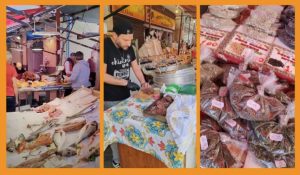
Il mercato del Capo
Siamo alle spalle del teatro Massimo, è lì che appena oltrepassata Porta Carini si apre un “mondo” palermitano al 100%. Il Mercato del Capo di Palermo è un gioiello storico e contemporaneo al tempo stesso situato nel cuore del capoluogo siciliano. Fondato nel X secolo durante la dominazione araba, questo vivace mercato è stato una pietra miliare della vita culinaria e culturale di Palermo per oltre un millennio. Inizialmente centro di scambio per commercianti e venditori locali, il Capo si è evoluto in un vivace mercato dove la tradizione incontra la modernità, offrendo uno sguardo affascinante sul ricco patrimonio della città e della Sicilia tutta.
Negli ultimi anni, il Mercato del Capo ha subito un notevole sviluppo, bilanciando la modernizzazione con il suo fascino storico. Gli sforzi per preservare il suo carattere tradizionale e migliorare le infrastrutture hanno dato nuova vita al mercato, attirando un numero crescente di visitatori. Nonostante questi cambiamenti, il Capo rimane un’amata fetta del passato di Palermo, dove l’essenza della cultura e della cucina siciliana continua a prosperare in mezzo al vivace trambusto della Palermo moderna.
Oggi il Mercato del Capo è una festa per i sensi; a volte è così pieno di persone che risulta complesso attraversarlo. Le strade strette e tortuose sono fiancheggiate da bancarelle colorate che traboccano di prodotti freschi, spezie aromatiche e deliziosi cibi di strada. Dai succulenti frutti di mare cucinati ad arte ai dolci appena sfornati, il mercato mette in mostra il variegato panorama gastronomico di Palermo: sono tantissime le occasioni e le modalità per apprezzarli, da ristoranti hipster a bancarelle improvvisate. Così come per il mercato di Ballarò, l’atmosfera vivace è esaltata dall’entusiasmo dei venditori e dai suoni ritmici della vita quotidiana del mercato, che lo rendono un luogo imperdibile sia per gli abitanti che per i turisti.
Un consiglio? Tra un succo di melograno e una sarda a beccafico, non lasciatevi sfuggire una delle nostre chiese preferite, l’Immacolata Concezione al Capo… un vero gioiello.
Il mercato di Borgo Vecchio
Siamo sempre nel cuore di Palermo, stavolta dietro il Teatro Politeama… per viottoli e stradine entriamo in uno dei più tipici quartieri di Palermo. Il mercato del Borgo Vecchio è un splendente spaccato di vita palermitana che affascina i visitatori da secoli. Fondato originariamente nel XII secolo, questo vivace mercato si è trasformato da modesto punto di scambio in un animato centro di aggregazione ricco di sapori e di carattere locale al 100%. Nel corso degli anni, ha visto innumerevoli cambiamenti, riflettendo il ricco arazzo della storia e della cultura di Palermo.
Oggi Il Borgo Vecchio è una delizia sensoriale, dove l’aroma dei prodotti freschi e il vivace chiacchiericcio di passanti, residenti e turisti riempiono l’aria. Troverete di tutto, da bancarelle, a negozi, a ristoranti a la page fino a trattorie super storiche. Anche questo mercato meno battuto dai turisti offre un enorme assortimento di prodotti, da frutta e verdura colorata a spezie profumate a street food per tutti i gusti.
Più dei precedenti Borgo Vecchio è una vera e propria comunità, troverete spesso concerti, eventi e feste patronali nella piazza principale del mercato.
I mercati storici di Palermo sono veri e propri tesori della cultura siciliana in generale e specchio di quella palermitana. Ballarò, la Vucciria, il Capo e il Borgo Vecchio offrono un’esperienza unica, ricca di colori, profumi e tradizioni che raccontano la storia della città. Non possono mancare nei vostri programmi di viaggio, ogni mercato è un vivace angolo di autenticità dove puoi assaporare la vera essenza di Palermo.[:en]
From historic markets to lavish palaces, the charm of Sicily is truly unrivaled. Each region and city has its own unique stories and culture. As the largest city and the island’s capital, Palermo offers a special charm through its amalgamation of traditional cultures and its lively dynamics that are summed up in its markets.
Palermo’s ancient times and Arab influences
The city of Palermo has been a crossroads of empires throughout its history, each of which has left a unique imprint on the city’s culture and character. Greeks, Romans, Byzantines, Arabs, and Normans brought with them unique heritages that today are reflected in the architecture, cuisine, and traditions of the area or even just in the gestures or speech of the people of Palermo.
Founded in 734 B.C. by the Phoenicians as a trading center, it was under Roman rule that the city began to prosper as a crucial part of the empire’s grain supply; the city’s fertile land and strategic location contributed to its importance as a strategic grain resource.
Under Arab rule in the 9th century, Palermo experienced a true “golden age.” This positive turning point was characterized by economic prosperity, intellectual activities, and artistic innovation. The Arabs introduced highly advanced irrigation systems, new crops such as citrus fruits, and a distinctive and typical architectural style that still connotes Palermo today that blended Islamic, Byzantine, and Norman elements. This style is still visible today in the city’s mosaics, domes, and arches, particularly in landmarks such as the Palatine Chapel and the Zisa Castle.
The Arabs brought important innovations to Sicily and Palermo; significant were their contributions in the field of medicine, with the creation of hospitals and the introduction of new health treatments and remedies.
An imprint still visible today…Palermo’s markets, such as the world-famous Ballarò and Vucciria, echo the lively souks of North Africa, with vendors selling spices, olives, and sweets reminiscent of Middle Eastern bazaars.
Ballarò: the most antic and lively market
The Ballarò market in Palermo is a living icon of Sicilian tradition and culture; it has been a pulsating corner of daily life in Palermo for centuries and is still super active today. Located in the heart of the city’s historic center, Ballarò is renowned not only for its rich offering of any product and food but also for its deep connection to local history and traditions.
The roots of the Ballarò market go back to the time of the Arab occupation of Sicily, which as mentioned above, dates back to the 9th century. During this period, Palermo became a thriving commercial and cultural center, and the Ballarò market emerged as a focal point for the exchange of goods from different parts of the Mediterranean. The name “Ballarò” is commonly traced back to the Arabic word “balhar,” meaning “confusion” or “tumult,” evoking the image of a lively and chaotic place, a reflection of its characteristic and dynamic atmosphere.
As you stroll through the narrow market streets, you will find yourself immersed in a vibrant environment of scents, sounds, faces, ethnicities, languages, and accents–an explosion of sounds and colors. The incessant chatter of vendors offering their wares that reaches apex tones in the classic “barking” (shouting of the traders), the clatter of moving pots and pans, and the irresistible smells of street food create a unique sensory experience. Vendors are very often the real stars of the market; they are known for their enthusiasm and ability to engage passersby with their stories and offerings.
[Best_Wordpress_Gallery id=”299″ gal_title=”mercato storico palermo ballarò”]
Among the gastronomic specialties you will find, arancine (delicious stuffed, breaded and fried rice balls) (beware, in Palermo “are females,” sfincione (a typical Palermo rustic pizza filled with onions and anchovies) and panelle (typical chickpea fritters, the city’s true street food) are just some of the delicacies that enrich the culinary offerings. In addition, the market offers a wide range of the freshest fish dishes, homemade pasta, and other typical specialties that celebrate Sicily’s rich culinary tradition.
The eclectic variety of produce available at the Ballarò market is amazing. From fresh fruits and vegetables, often locally grown, to unique handicrafts, antiques modern antiques, and quaint souvenirs, the market is a haven for those seeking authenticity and originality. Each stall tells a story, and the ability to bargain directly with vendors adds an extra layer of involvement and interaction.
But Ballarò is much more than just a market: it is a stage for Palermo’s living culture; here, encounters between ethnicities, statuses, locals, and tourists are continuous allowing for the discovery of customs, traditions, and personal stories that enrich the visitor’s experience. Conversations with vendors and residents offer an authentic glimpse into daily life, far from the traditional tourist circuits.
The Ballarò market is an extraordinary place for photography enthusiasts…the vibrant atmosphere, the vibrant colors of the produce and stalls, and the murals that adorn the surrounding walls offer endless opportunities for memorable shots. Every corner of the market, with its vibrant scenes and unique details, is a perfect canvas for capturing the essence of Palermo and its vibrancy.
In summary, the Ballarò market is not just a destination for buying goods and food; it is a celebration of Palermo’s culture and history, an immersive experience that offers an authentic glimpse into Sicilian life and an unmissable opportunity for all the senses.
La Vucciria
It used to be one of the best known, but today it has abandoned its commercial identity and has become a crossroads for young people and tourists. Palermo’s Vucciria Market is a vibrant corner of Palermo life with a history rich in ancestors, familiar faces, and art. Founded in the 12th century, over the centuries, the Vucciria has witnessed many changes, reflecting the broader changes in Palermo itself. During the 19th and early 20th centuries, it was renowned for its vibrant atmosphere and the variety of its offerings, making it a must-visit place for anyone seeking an authentic taste of city life; hence, famous faces and celebrated artists also wanted to immortalize it as a symbol of the city. Today, despite the challenges it has faced, such as economic changes and urban redevelopment, the Vucciria has managed to retain its character and charm, adapting to modern times and opening up more and more to tourists.
You will find typical trattorias, benches, chairs, stools, street food, and why not real collective dance sessions in this epicenter of local culture.

Capo Market
We are behind the Teatro Massimo, that’s where just past Porta Carini a 100 percent Palermo “world” opens up. Palermo’s Capo Market is both a historical and contemporary gem located in the heart of the Sicilian capital. Founded in the 10th century during Arab rule, this bustling market has been a cornerstone of Palermo’s culinary and cultural life for more than a millennium. Initially a trading center for local merchants and vendors, the Capo has evolved into a bustling market where tradition meets modernity, offering a fascinating glimpse into the rich heritage of the city and Sicily as a whole.
In recent years, the Mercato del Capo has undergone considerable development, balancing modernization with its historic charm. Efforts to preserve its traditional character and improve infrastructure have breathed new life into the market, attracting increasing numbers of visitors. Despite these changes, the Capo remains a beloved slice of Palermo’s past, where the essence of Sicilian culture and cuisine continues to thrive amid the bustling hustle and bustle of modern Palermo.
Today’s Capo is a feast for the senses; at times it is so packed with people that it is complex to walk through. The narrow, winding streets are lined with colorful stalls overflowing with fresh produce, aromatic spices, and delicious street food. From succulent seafood artfully cooked to freshly baked desserts, the market showcases Palermo’s diverse food scene: there are plenty of opportunities and ways to enjoy them, from hipster restaurants to makeshift stalls. Just as with the Ballarò market, the lively atmosphere is enhanced by the enthusiasm of the vendors and the rhythmic sounds of daily market life, making it a must-see for locals and tourists alike.
A word of advice? Between a pomegranate juice and a sarda a beccafico, don’t miss one of our favorite churches, the Immacolata Concezione al Capo–a real gem.
Borgo Vecchio Market
We are still in the heart of Palermo, this time behind the Politeama Theater…through alleys and narrow streets we enter one of Palermo’s most typical neighborhoods. The Borgo Vecchio market is a shining cross-section of Palermo life that has fascinated visitors for centuries. Originally founded in the 12th century, this bustling market has evolved from a modest trading post into a bustling hub full of flavor and 100 percent local character. Over the years, it has seen countless changes, reflecting the rich tapestry of Palermo’s history and culture.
Today, Il Borgo Vecchio is a sensory delight, where the aroma of fresh produce and the lively chatter of passersby, residents, and tourists fill the air. You’ll find everything from stalls to stores, to a la-page restaurant to super historic trattorias. Even this market less traveled by tourists offers a huge assortment of produce, from colorful fruits and vegetables to fragrant spices to street food for all tastes.
More than the previous Borgo Vecchio is a true community, you will often find concerts, events, and patron festivals in the market’s main square.
Palermo’s historic markets are true treasures of Sicilian culture and reflection of Palermo’s life. Ballarò, the Vucciria, the Capo, and the Borgo Vecchio offer a unique experience, full of colors, scents, and traditions that tell the story of the city. They cannot be missed in your travel plans, each market is a lively corner of authenticity where you can savor the true essence of Palermo.[:]
Vuoi iscriverti alla nostra newsletter e rimanere sempre aggiornato?
